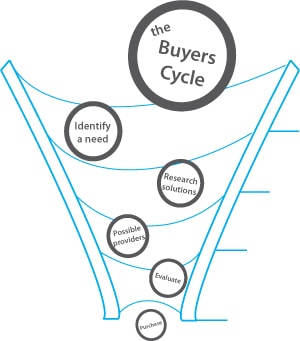Anjrahweb.Com – Kata Para Pakar, Kalau mau sukses jualan online, pahamilah Buying Cycle Bagan Tahapan Keputusan Pembelian Konsumen Itu Seperti Apa. Nah, ini menarik. Mari kita coba bedah apa sih yang dimaksud dengan istilah di atas.
Agar tidak kejauhan, tempatkan pada diri anda sendiri untuk meraba tahapan keputusan pembelian konsumen di dunia online.
Kalau anda sendiri, apa lihat barang langsung beli? Atau karena jaman dulu pernah belajar tentang produk itu, sudah lama tersimpan dalam memori kita. Pas butuh kayak ada kaset rekaman yang diputarkan di kepala kita memunculkan pengalaman belajar kita tentang sesuatu produk / jasa tersebut.
Buying Cycle Bagan Tahapan Keputusan Pembelian Konsumen
Ngepasin muncul iklannya, lalu kita membeli. Iya apa iya? agar lebih jelas, bari kita bedah saja keputusan pembelian menurut para ahli dalam konsep seperti berikut:
Temen temen bisa lihat, dari sisi pembeli melalui beberapa tahapan:
- Pembeli mulai mengidenfitikasi dia itu punya suatu kebutuhan (Identify A Need). Ehm, saya butuh lebih cantik nih secara penampilan.
- Biasanya, dia akan mulai research solutions. Kalau jaman now, buka google apa youtube. Ya kan? he he.
- Dari hasil youtube / googling atau cari cari info tadi. Dia akan menemukan ragam possible providers (pemberi pemberi solusi yang memungkinkan). Bisa jadi salah satunya anda.
- Sebelum membeli, pembeli akan mulai evaluate. Pembeli melakukan evaluasi atas apa yang dia dapat sebelumnya. Milih yang mana, sisi kelebihan dan sisi kekurangannya dia timbang baik baik. Sampai akhirnya dia melakukan:
- Purchase.
Apa berhenti disitu? Tentu tidak. Bisa jadi dia akan repurchase atau kecewa dan dia tak pernah lagi kembali ke bisnismu. Maka, amat sangat penting bagi seorang penjual guna melakukan followup kepada customernya.
Bagaimana Kalau Kita Cermati keputusan membeli produk dari sisi Penjual?
Agak sedikit berbeda sih, tapi filosofinya sama. Dikenal ada istilah suspect lead prospect client. Coba langsung cermati saja bagan berikut (walau sedikit beda) ini:
Alurnya:
- Kita akan memancing datangnya suspect dan termasuk orang orang yang penasaran. Kita tarik dengan tawaran tawaran yang ‘menarik’ mereka. Ditarik buat baca dan cari tahu ke website kita lebih jauh. Memancing cold market menuju warm market.
- Lalu jadilah dia visitor website kita. Dibaca baca, mendalami penawaran yang kita sampaikan. Sehingga dia mengerti, tau isi produknya dan paham apa benefit yang bakal dia terima. Jadilah Prospect. Warm market.
- Dia mulai mengkontak CS / Admin toko kita. Maka disini dia sudah berubah dari sekedar prospect menjadi sosok lead. Lead ini tinggal di followup, diberikan penawaran yang tepat, syukur bonus apa dan diskon apa kalau transfer sebelum jam 12.00 gitu.
- Goal orangnya transfer, maka jadilah dia CLIENT kita.
- Klien yang kita rawat dengan baik, komplainnya diselesaikan dengan tuntas, produk kita emang bagus. Dia akan jadi ambassador ‘gratisan’ bagi bisnis kita. Kayak saya tuh, saya suka makan di mie ayam enak bakso tengkleng mas bambang. Kemana mana saya promosikan, kalau mau makan mie ayam enak ya disitu.
Paham ya sekarang mengapa kita perlu membuat artikel di website dengan kata kunci yang teroptimasi baik alias di SEO-kan?
Agar bisa mendapatkan lead lead yang berkualitas sehingga mudah di convert jadi client. Kata kunci yang pas, akan mendatangkan calon pembelia yang pas juga.
Semoga paparan mengenai Buying Cycle Bagan Tahapan Keputusan Pembelian Konsumen Bisa menginspirasi anda semua. Ada pertanyaan? Silakan komentar saja ya.







No comment yet, add your voice below!